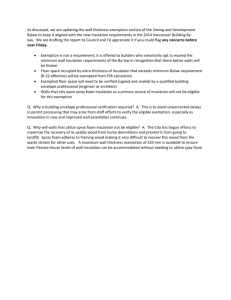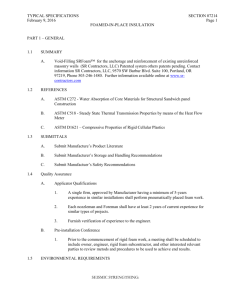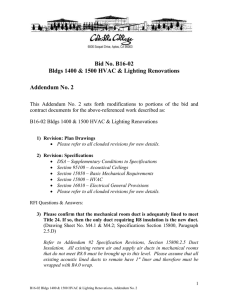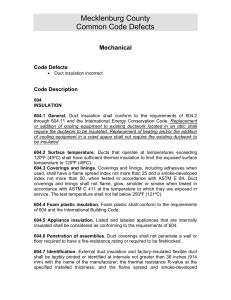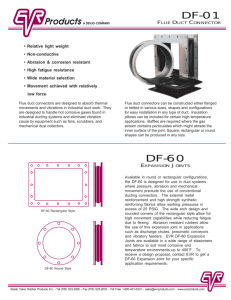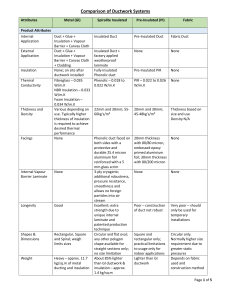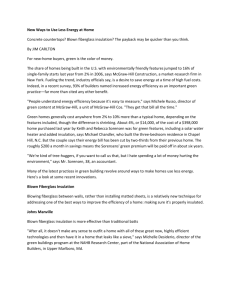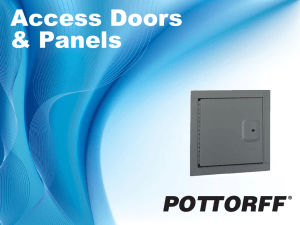Precision Mechanical Systems - Mills Brothers Heating & Air
advertisement
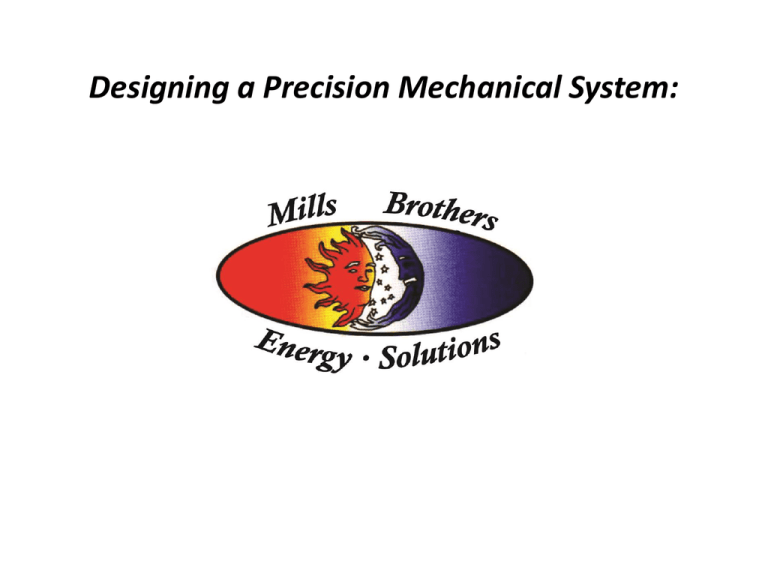
Designing a Precision Mechanical System: Referring to local new construction, remodeling projects (including historic renovations), this course will explain the impact of designing a precision mechanical system and the various energy solutions available to make the home as energy efficient as possible. The coastal environment presents many building envelope problems. Today we will identify the most common failures in the envelope and discuss how to avoid them in the design phase. BUILDING ENERGY CODES Today’s energy, economic, and environmental challenges—combined with the fact that buildings consume nearly 40% of the nation’s energy—make energy codes a central part of a sustainable future. Top Ten Reasons for Building Energy Codes 10. PROVIDE a common foundation for evaluating, regulating, and incentivizing building design, construction, technologies, and performance. 9. SUPPORT energy conservation and efficiency actions beyond minimum code levels. 8. HELP drive the development and deployment of new building technologies and design strategies. 7. PROVIDE a cost-effective step toward mitigating problems associated with growing demand for energy and power resources. 6. INCREASE the use of energy efficient technologies proven through incentive programs, freeing up resources to focus on new, more efficient additional technologies. Energy Codes Continued 5. PROVIDE a common basis upon which to educate the building design and construction community in energy efficiency. 4. SAFEGUARD owners and tenants from long term financial burdens that can result from short-term design and construction decisions. 3. CONTINUE to progress in terms of stringency, scope, and enforcement emphasis—all of which provide new jobs or opportunities to enhance the skills of the current workforce. 2. HELP protect the natural environment from unnecessary emissions. 1. ENERGY CODES not only save money, but also help to reduce needless consumption of energy to heat, cool, light, ventilate and provide hot water for newly built residential and commercial buildings constructed without adequate energy efficiency features. www.energycodes.gov IDENTIFYING THE PROBLEMS! Energy Evaluations Energy Audits IAQ Tests Manual J Heat Load Calculations Energy Evaluations An Energy Evaluation is an initial inspection of a homes largest energy consumers. • • • • • HVAC Hot Water Windows Glazing Ductwork and location of ductwork • Fireplaces • Attics and Crawlspaces • Visual inspection of entire envelope Energy Audits An Energy Audit can help you assess how much energy your home uses and evaluate what measures you can take to improve efficiency. Thorough audits often use equipment such as blower door tests, which measure the extent of home infiltration in the building envelope, and infrared cameras, which reveal hard to detect areas of air infiltrations and missing insulation. IAQ Tests Indoor Air Quality Tests: Used after the Energy valuation if the presence of old is found in the home. A sample of the existing mold issues would be gathered and sent to a third party laboratory for evaluation. Manual J and D Heat Load Calculations: The Correct Way to Size a System Key factors for correctly sizing a heating And cooling system include the following: • Local Climate • Size, Shape, and Orientation of the house • Insulation Levels • Window area, location, and type • Air infiltration rates • The number and ages of occupants • Occupant comfort preferences • The types and efficiencies of lights and major home appliances (which give off heat). Solutions! • Properly sized Energy Efficient HVAC system • Proper location of ductwork • Tankless Hot Water Heaters • Insulation • Enclosed Crawl Space Dehumidification • Energy Efficient Windows, Sliding Glass Doors and French Doors Energy Efficient HVAC Systems Proper Size! Age of Unit! The most common sizing mistake is in over-sizing. This not only makes the new system more expensive to install, but also forces it to operate inefficiently, break down more often, and cost more to operate. Oversized heating equipment also often creates uncomfortable and large temperature swings in the house. Oversized air conditioners do not run long enough to dehumidify the air, which results in the “clammy” feeling and unhealthy mold growth in many air-conditioned houses. Tankless Hot Water Heaters Heating water accounts for up to 30 percent of the average home's energy budget. Gasfired tankless water heaters can cut your energy costs up to half over regular storage heaters. INSULATION Open Cell Foam Low-density, spray-applied polyurethane foam. Porous, not a vapor barrier, no added structural stability, R Value 3.8 per 1 inch. INSULATION Closed Cell Foam Polyurethane insulation that delivers high Rvalue plus Air Barrier, moisture vapor retarder, and water barrier that blocks air infiltration and air-borne pollutants while controlling moisture movement to provide increased comfort with lower energy usage. Enclosed Crawl Space Dehumidification Around the year 2015, energy code will state that all duct work is to be in conditioned space. In our Warm and humid climate zone, moldy duct work is A common issue. Crawl spaces where duct work exists that are not dehumidified are a breeding ground for mold and other indoor air quality issues. This can lead to Structural issues, swelling and cupping of Hardwood floors, and certain health issues. Energy Efficient Windows, Sliding Glass Doors and French Doors • Keep fenestration below 20% window to wall area • R-3 Window vs R-13 wall • Solar Heat Gain • Windows get covered up anyway! Heat Gain and Loss Windows, doors, skylights can gain and lose heat in the following ways: U-factor--The rate at which a window, door, or skylight conducts non-solar heat flow. The lower the U-factor, the more energy-efficient the window, door, or skylight. Solar heat gain coefficient (SHGC)--A fraction of solar radiation admitted through a window, door, or skylight—either transmitted directly and/or absorbed, and subsequently released as heat inside a home. The lower the SHGC, the less solar heat it transmits and the greater its shading ability. Air leakage--The rate of air infiltration around a window, door, or skylight in the presence of a specific pressure difference across it. A product with a low air leakage rating is tighter than one with a high air leakage rating. New Construction Scope of Work—New Construction Process • Met with Architect and Homeowner to go over copy of finalized plans and building materials in order to begin designing the homes mechanical system. • New home specifications were entered into Manual J Heat Load Calculation. • The thermal envelope is the most important concern for the manual j and then the major appliances and energy consumers in the home. • This was a brick home built on a slab. No soffet or ridge vents were installed in this construction. The home was spray foamed from the floor at the slab all the way to the roof with a mixture of open and closed cell foam. COMPLETE ENCAPSULATION! • Due to the size of the home, 3200 SQ. FT. one level home, we chose 22 stage split heat pumps with variable speed air handlers. This allows for more capacity when needed during hotter months, and less capacity, using less energy when the heat load is not as demanding. The 2 stage with variable speed is controlled by a thermostat that doubles as a humidistat to allow for better dehumidification. • Windows were double pane low E. • Tankless hot water heater installed sized to consumers usage and need. • Because of complete spray foam encapsulation, all duct work was in conditioned space. Remodel or Retro-fit • • • • Home energy evaluation performed. 1700 SQ FT Ranch home built in 1954 on a slab. Old windows and doors. Un-insulated Gas Tank Style Hot Water Heater approximately 15 years old. • Duct work was leaky and the insulation on the duct work was breaking down. It was located in a unconditioned, unvented attic. • HVAC system was approximately 15 years old. • Blown insulation in attic approximately R15.
